The Root
Chapter 5
Morphology of flowering plants
Angiosperms have a wide range of exterior forms or morphology, but they all have roots, stems, leaves, flowers, and fruits in common. Flowers and fruits may be present. The root system of a flowering plant is underground, whereas the component above ground is called the shoot system.
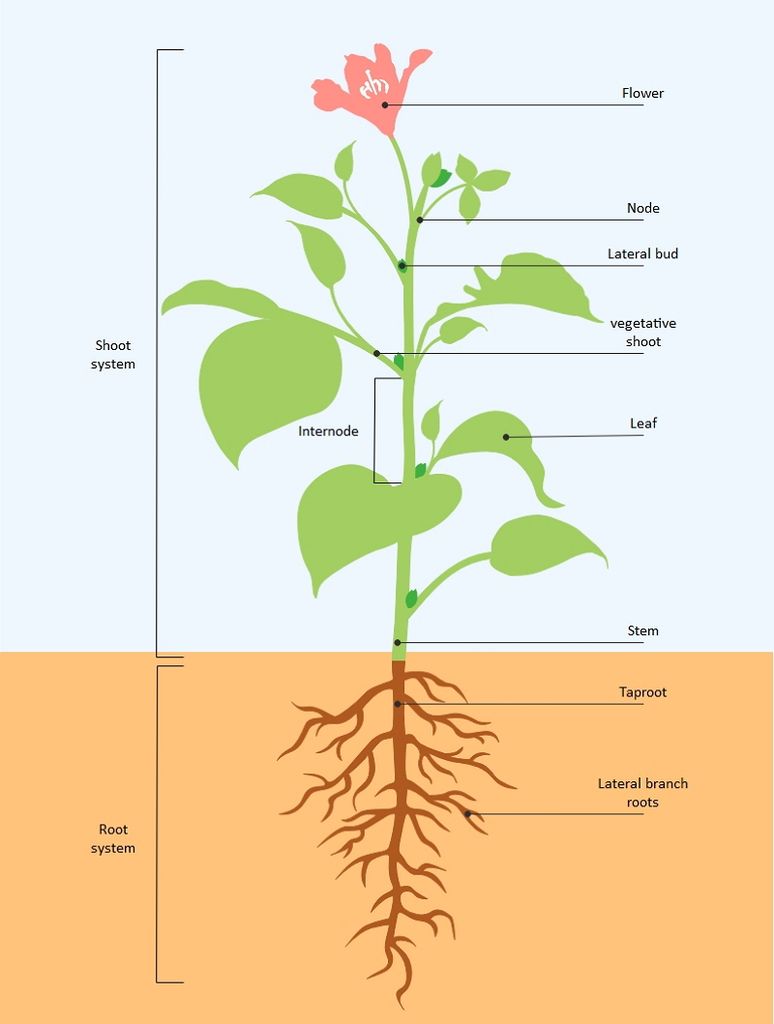
The Root
All vascular plants have roots, which are a crucial subterranean component. This portion of the plant is primarily responsible for attaching it to the ground and absorbing the soil's necessary mineral components, nutrients, and water. It can also be used to keep food.
Types of roots:In the majority of dicotyledonous plants, direct radicle elongation results in the creation of the main root that grows inside the soil. It has lateral roots of several orders, referred to as secondary, tertiary, and so on. This is called the taproot system, as shown in the mustard plant. It is made up of the major roots and their branches. The primary root of monocotyledonous plants is short-lived and is replaced by a vast number of roots.As shown in the wheat plant, these roots grow from the base of the stem and form the fibrous root system.
Adventitious roots emerge from portions of the plant other than the radicle in some plants, such as grass, Monstera, and the banyan tree. Absorption of water and nutrients from the soil, appropriate anchorage of plant parts, storage of reserve food material, and synthesis of plant growth regulators are the key tasks of the root system.
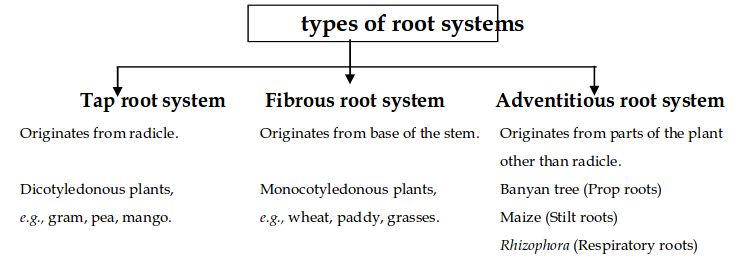
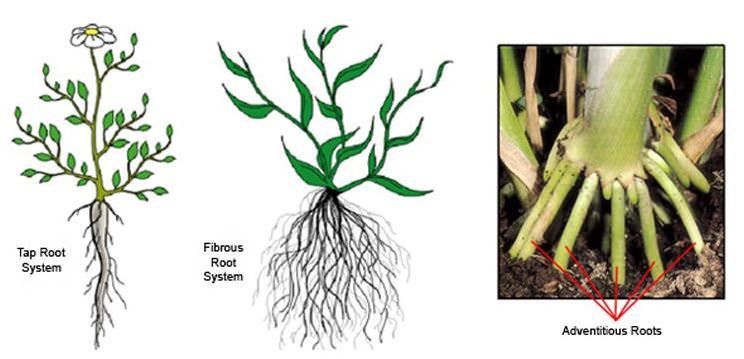
Regions of a root:The root cap is a thimble-like structure that covers the root at its tip. It shields the root's fragile apex as it travels through the soil. Meristematic activity occurs a few centimeters above the root cap. This region's cells are tiny, thin-walled, and have thick protoplasm. They repeatedly divide. The cells closest to this region experience rapid elongation and expansion, and they are responsible for the root's length growth. The elongation region is the name given to this area. The elongation zone's cells mature and differentiate throughout time. As a result, the zone proximal to the region of elongation is known as the maturation zone.Root hairs are incredibly tiny and fragile thread-like structures formed by epidermal cells in this region. The soil's water and minerals are absorbed by these root hairs.
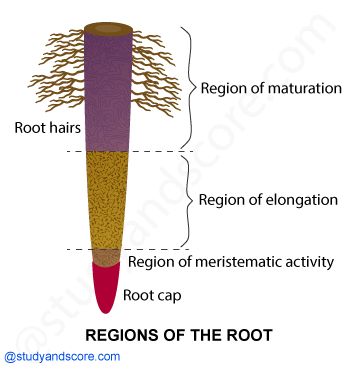
Modifications of a root:Some plants' roots change shape and structure, allowing them to perform roles beyond water and mineral absorption and conduction. They've been altered to provide support, food storage, and breathing. Carrot, turnip, and sweet potato adventitious roots are used for the storage of food in plants. Prop roots are the hanging structures that support a banyan tree. Similarly, maize and sugarcane stems have supporting roots that emerge from the lower nodes of the stem. They are called Stilt roots. Many roots emerge from the ground and climb vertically upwards in plants like Rhizophora that flourish in swampy environments. Pneumatophores are roots that aid in the acquisition of oxygen for breathing.
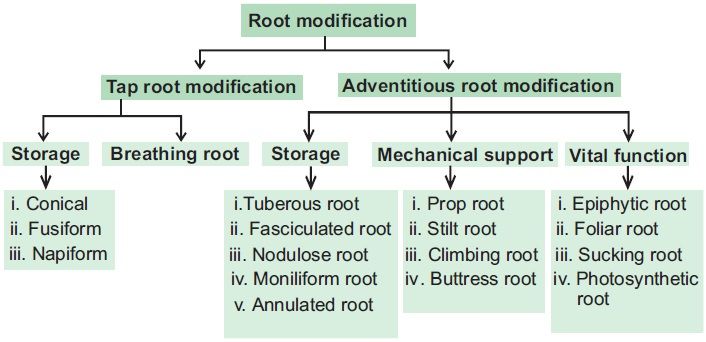
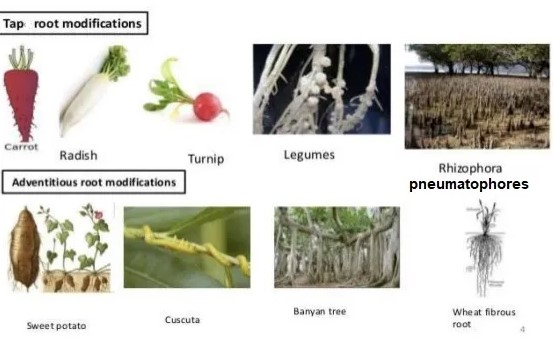
The Stern
The Stem
A stem is one of a vascular plant's main structural axes. It provides support for leaves, flowers, and fruits, distributes the water and dissolved chemicals between the roots and the shoots in the xylem and phloem, stores nutrients, and generates new living tissue. The stem is the section of the axis that ascends and bears branches, leaves, flowers, and fruits. It grows from the plumule of a sprouting seed's embryo. Nodes and internodes are found on the stem. Nodes are the parts of the stem where leaves are born, whereas internodes are the parts between two nodes. The stem produces buds that are either terminal or axillary. When young, the stem is usually green, but as it matures, it becomes woody and dark brown.
The stem's primary job is to spread out branches containing leaves, flowers, and fruits. Water, minerals, and photosynthates are all carried by it. Some stems have multiple functions, including food storage, support, protection, and vegetative propagation.
Modifications of a Stem: Stems havebeen altered to do various tasks. In potato, ginger, turmeric, zaminkand, and Colocasia, underground stems have been adapted to store food. They also serve as perennation organs, allowing them to survive in environments that are not conducive to growth. Stem tendrils, which emerge from axillary buds and are slender and spirally coiled, assist plants in climbing, such as cucumbers, pumpkins, and melons. Stem axillary buds can also be transformed into woody, straight, and pointed thorns.
Many plants, such as Citrus and Bougainvillea, have thorns. They keep animals from eating the plants. Arid-climate plants change their stems into flattened (Opuntia) or fleshy cylindrical (Euphorbia) forms.They have chlorophyll and are capable of photosynthesis.
Some plants, such as grass and strawberry, stretch underground stems to new niches, and new plants emerge as older sections die. A slender lateral branch emerges from the base of the main axis in plants like mint and jasmine, and after growing aerially for a time, arch downwards to touch the ground.
Aquatic plants like Pistia and Eichhornia have a lateral branch with short internodes and each node containing a rosette of leaves and a tuft of roots. The lateral branches of bananas, pineapples, and Chrysanthemums begin from the main stem's basal and underground portion, develop horizontally beneath the soil, and then emerge obliquely upward, giving rise to leafy shoots.
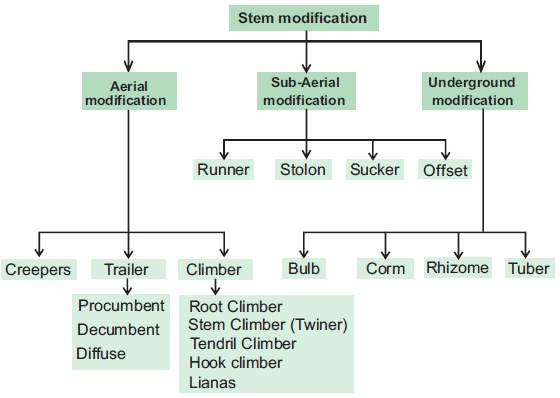
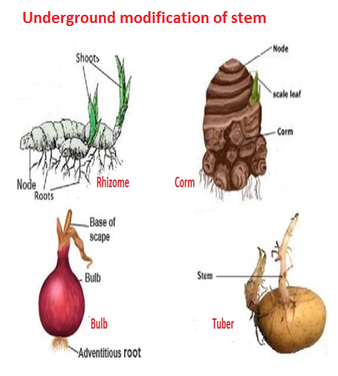

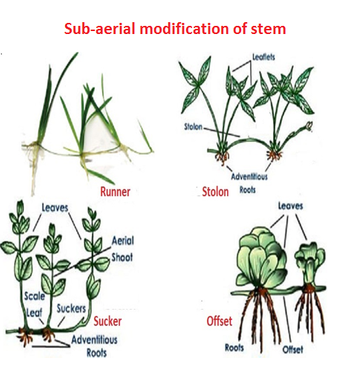
Figure 6(b): Stem modifications
The Leaf
The Leaf
The organ of plant that generates the major lateral appendage on the stem of vascular plants is referred to as a leaf. The leaf is a lateral, flattened structure that grows from the stem. It grows at the node and produces a bud in the axil. A branch arises from the axillary bud. Shoot apical meristems give rise to leaves, which are organized in an acropetal order. They are the most essential photosynthetic vegetative organs. It's also known as the plant's kitchen or food factory. This is due to the fact that they are the primary organ responsible for photosynthesis, which is how the plant obtains its energy or food. The presence of chlorophyll gives them their green color.
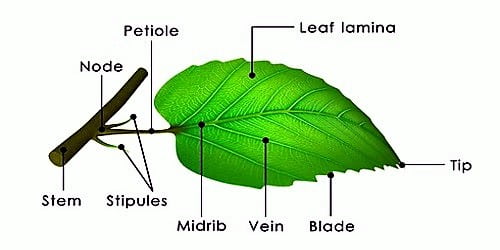
The leaf base, petiole, and lamina are the three main sections of a normal leaf. The leaf base connects the leaf to the stem, while stipules are two lateral tiny leaf-like structures. In monocotyledons, the leaf base develops into a sheath that partially or completely covers the stem. The pulvinus occurs when the leaf base of some leguminous plants becomes inflated. The petiole aids in keeping the blade lit. Leaf-blades flap in the breeze, cooling the leaf and delivering fresh air to the surface, thanks to long thin flexible petioles. The leaf blade, or lamina, is the extended green section of the leaf with veins and veinlets. There is frequently a conspicuous middle vein, referred to as the midrib.Veins give the leaf blade structure and serve as routes for water, minerals, and food components. The shape, edge, apex, surface, and extent of lamina incision vary amongst leaves.
Venation: Venation is the arrangement of veins and veinlets in the lamina of a leaf. The venation is called reticulate when the veinlets create a network. Examples: Hibiscus, papaya, leaves of Tulsi, Coriander, China Rose, and Mangifera. A type of reticulate venation pattern in which the secondary veins run parallel to each other from the midrib toward the margin is called pinnate venation. Examples include Alder, Chestnut, and Oak. Palmate is a venation pattern in which several main veins radiate outward from the base of the leaf. Examples are, Maple, Tulip etc. The venation is called parallel when the veins inside a lamina run parallel to one other. Example: banana, grass, and wheat. Most dicotyledonous plants have reticulate venation on their leaves, but most monocotyledons have parallel venation.A vascular arrangement in leaves such that the veins are forked, with each vein dividing at intervals into smaller veins of approximately equal size is called Dichotomous venation, for example, Ginkgo biloba.
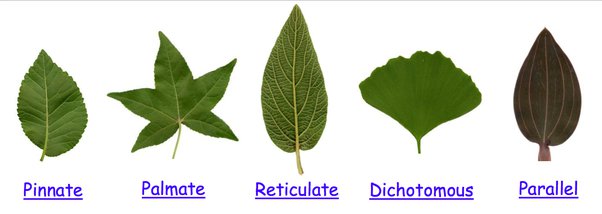
Types of leaves:
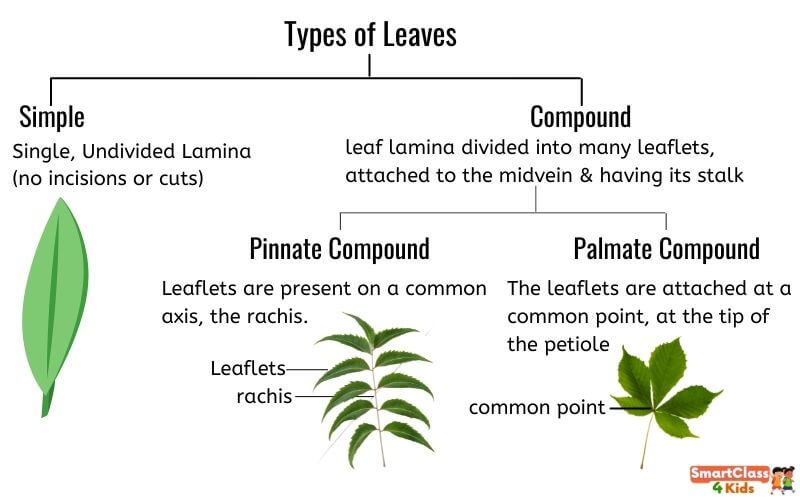
Different types of leaves are described below:
a) Simple leaf: When a leaf's lamina is complete or when the incisions do not touch the midrib, it is considered to be simple.
b) Compound Leaf: The leaf is considered compound when the incisions of the lamina go up to the midrib, breaking it into a number of leaflets. There are two types of compound leaves. As in neem, a pinnatelycompound leaf has a number of leaflets on a common axis, the rachis, which represents the leaf's midrib. The leaflets of palmately compound leaves are joined at a common point, the tip of the petiole, as seen in the silk cotton plant.
In both simple and compound leaves, a bud can be found in the axil of the petiole, but not in the axil of the leaflets.
Phyllotaxy:
The pattern of leaf arrangement on the stem or branch is known as Phyllotaxy. There are three varieties of this: alternate, opposite, and whorled. In alternate phyllotaxy, a single leaf emerges alternately at each node, as seen in China rose, mustard, and sunflower plants. As in Calotropis and guava plants, a pair of leaves emerges at each node and lies opposite each other. This is the opposite phyllotaxy. It is called whorled when more than two leaves emerge from a node and form a whorl, as in Alstonia.
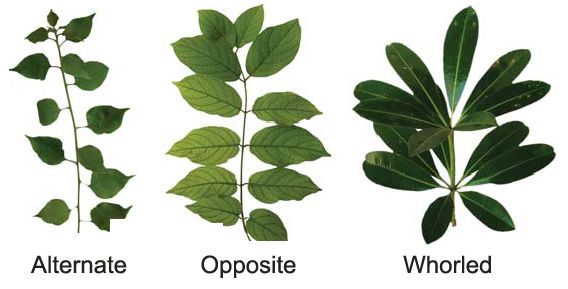
Modifications of a leaf:
Additional to photosynthesis, leaves are frequently adapted to fulfill other purposes. They are transformed into tendrils in peas for climbing and spines in cacti for defence. Onion and garlic leaves have fleshy leaves that store nourishment. The leaves of some plants, such as Australian acacia, are tiny and short-lived. These plants' petioles swell, turn green, and synthesize nourishment. Certain insectivorous plants, such as pitcher plants and venus fly traps, have modified leaves as well.
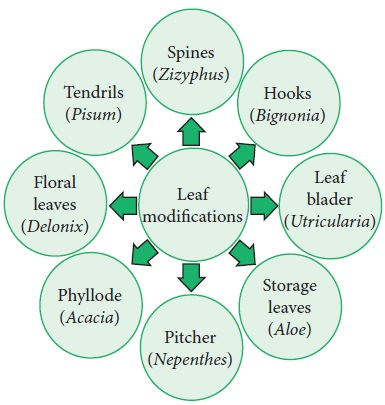
The Inflorescence
Inflorescence
The inflorescence is the arrangement of flowers along the floral axis. A flower is a modified shoot in which the apical meristem of the shoot transforms into the floral meristem. The axis becomes condensed as the internodes do not lengthen. Instead of leaves, the apex produces several types of floral appendages at successive nodes. The transformation of a shoot tip into bloom is always solitary. Two basic forms of inflorescences are described based on whether the apex develops into a flower or continues to grow:
1. Racemose. The primary axis of racemose inflorescences continues to grow, but the flowers are carried laterally in acropetal succession. Younger flowers are present at the tip while older flowers are arranged at the base of this inflorescence. Example: Mustard, Snapdragon, Gulmohar, Wheat, Barley, Parsley.
2. Cymose: The primary axis of a cymose inflorescence terminates in a flower, limiting its expansion.The flowers are borne in a basipetal order. Younger flowers are present at the base of the inflorescence, while older flowers are present at the top. The cymose inflorescence is present in plants like Solanum nigrum, Drosera, Begonia, Ranunculus, Jasmine, Calotropis, etc.
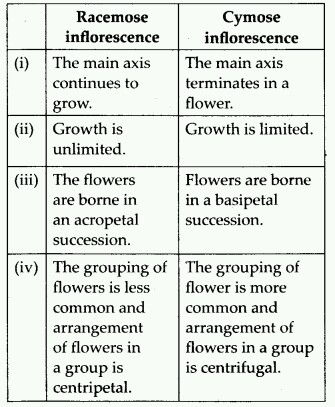
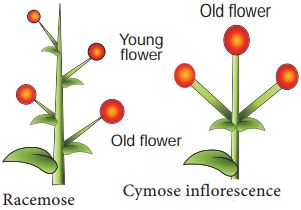
The Flower
The Flower
In angiosperms, the flower is the reproductive unit. It's designed to be used for sexual reproduction. On the swollen end of the stalk or pedicel, called the thalamus or receptacle, a typical flower has four different kinds of whorls placed sequentially. Calyx, corolla, androecium, and gynoecium are the four flower parts. Androecium and gynoecium are reproductive organs, while calyx and corolla are accessory organs. The calyx and corolla of some flowers, such as lilies, are not distinct and are referred to as perianth. A flower is bisexual if it has both androecium and gynoecium. Unisexual flowers are those that have only stamens or carpels.
The flower can be actinomorphic (radial symmetry) or zygomorphic (bilateral symmetry). Flowers that have multiple lines of symmetry (like a starfish) are radially symmetrical, also called actinomorphic. Flowers with only a single line of symmetry are bilaterally symmetrical, also called zygomorphic. Actinomorphic flowers, such as mustard, datura, and chilli, can be divided into two equal radial halves in any radial plane running through the centre. It is zygomorphic when it can be separated into two comparable halves only in one vertical plane, as in pea, Gulmohar, bean, and Cassia. If a flower, like canna, cannot be divided into two comparable halves by any vertical plane going through the centre, it is asymmetric (irregular).
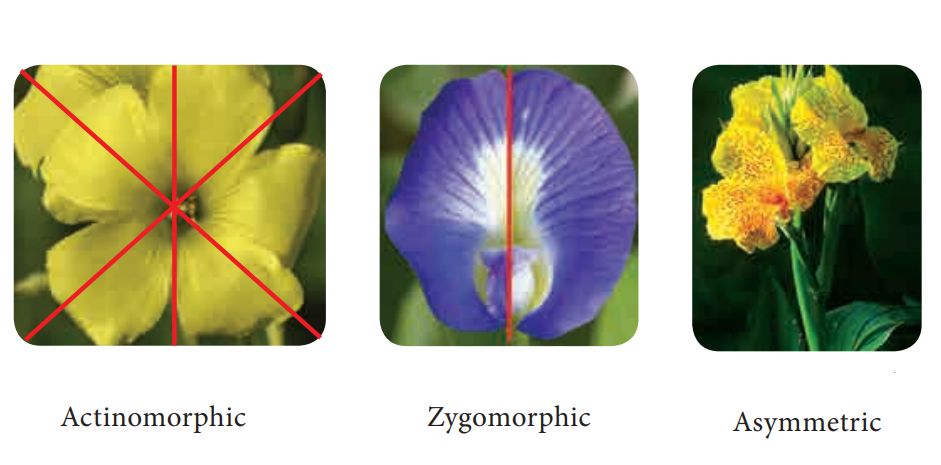
Trimerous, tetramerous, and pentamerous flowers have floral appendages in multiples of 3, 4, and 5, respectively. Bracteate flowers have a shortened leaf at the base of the pedicel, whereas ebracteate flowers do not have one. Flowers are classified as hypogynous, perigynous, or epigynous based on the position of the calyx, corolla, and androecium in relation to the ovary on the thalamus. The gynoecium is at the top of the hypogynous flower, with the other sections below it. Such flowers, such as mustard, China rose, and brinjal are said to have superior ovaries. If the gynoecium is in the center and the other parts of the flower are virtually at the same level as the thalamus rim, the flower is said to be perigynous.Plum, rose, and peach, for example, have a half inferior ovary. The thalamus margin develops upward in epigynous flowers, entirely enclosing and fusing with the ovary; the other parts of the flower ascend above the ovary. As a result, the ovary is reported to be inferior in guava and cucumber flowers, as well as sunflower ray florets.

Parts of a flower include:

Calyx: The calyx is the flower's outermost whorl, and the sepals are its members. Sepals are green, leaf-like structures that protect the flower at the bud stage. The calyx can be gamosepalous (sepals together) or polysepalous (sepals apart) (sepals free).
Corolla: Petals make up the corolla. Petals are typically vividly coloured to attract pollinating insects. Corollas can be gamopetalous (petals joined) or polypetalous, just as the calyx (petals free). Plants have a wide range of corolla shapes and colours. Tubular, bell-shaped, funnel-shaped, or wheel-shaped corollas are all possible.
Aestivation refers to the way sepals or petals in a floral bud are arranged in relation to the other members of the same whorl. Valvate, twisted, imbricate, and vexillary aestivation are the most common kinds. Valvate describes a whorl in which the sepals or petals only touch at the margin, without overlapping, as in Calotropis. Twisted means that one appendage's edge overlaps the next and so on, as in the china rose, lady's finger, and cotton. Imbricate aestivation occurs when the borders of sepals or petals overlap but not in any specific direction, as in Cassia and Gulmohar.The largest (standard) petal overlaps the two lateral petals (wings), which overlap the two smallest anterior petals (keel) in pea and bean flowers; this type of aestivation is known as vexillary or papilionaceous.
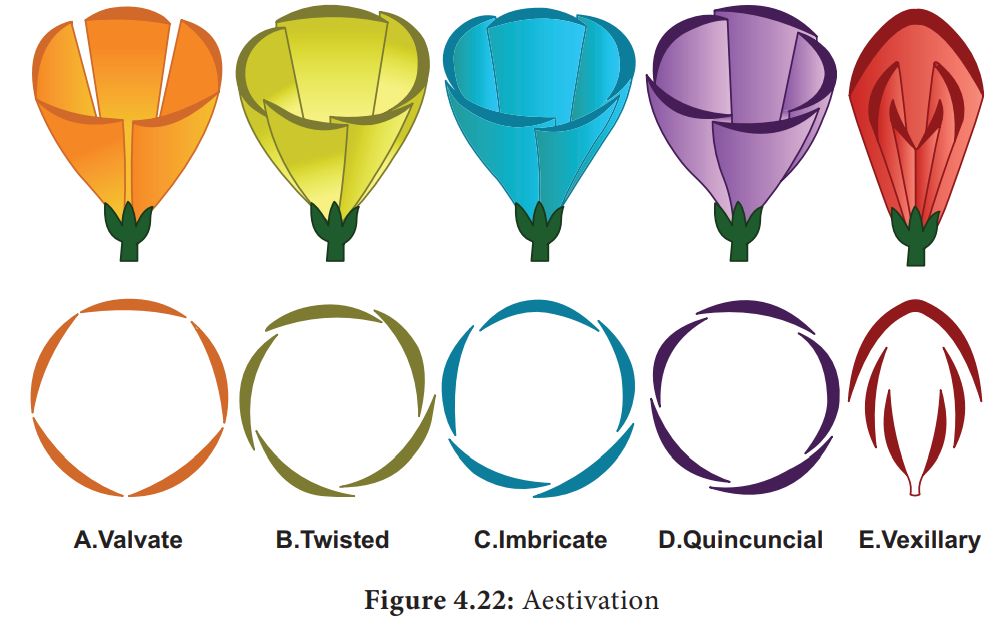
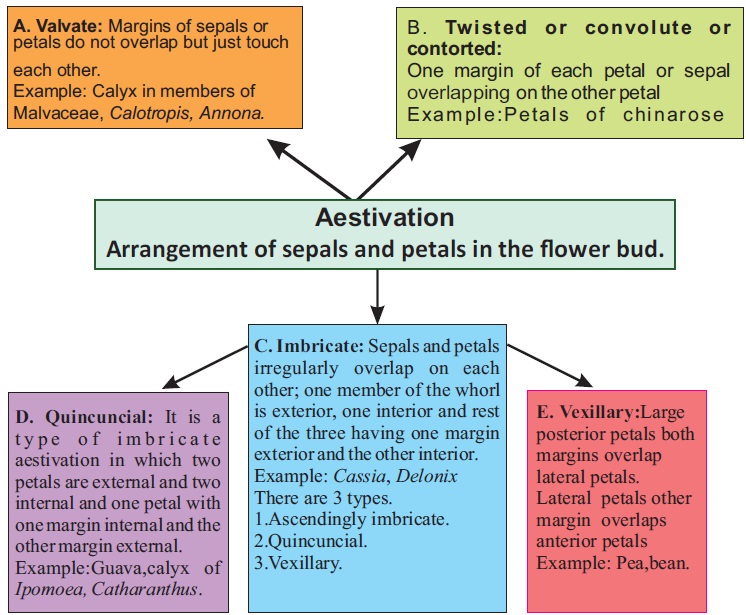
Androecium: Stamens make up the androecium. A stalk or filament and an anther make up each stamen, which represents the male reproductive organ. Each anther is normally bilobed, with two pollen-sac chambers in each lobe. Pollen grains are manufactured in pollen sacs. The staminode is a sterile stamen. Flower stamens can be joined to other components of the flower, such as petals, or to each other. Stamens are epipetalous when attached to the petals, as in brinjal, or epiphyllous when attached to the perianth, as in lily flowers. A flower's stamens can either remain free (polyandrous) or be joined to varying degrees.The stamens can be grouped into a single bunch or bundle (monoadelphous), two bundles (diadelphous), or more than two bundles (polyadelphous) as in China rose. Within a flower, filament length can vary, as in the case of Salvia and mustard.
Gynoecium: The female reproductive component of the flower is the gynoecium, which is made up of one or more carpels. The stigma, style, and ovary are the three sections of a carpel. The expanded basal portion of the ovary is where the elongated tube, the style, is located. The ovary is linked to the stigma by the style. The stigma is the receptive surface for pollen grains and is usually found at the tip of the style. One or more ovules are linked to a flattened, cushion-like placenta in each ovary. When more than one carpel is present, it is referred to as apocarpous as in lotus and rose. When carpels fuse, as in mustard and tomato, they are called syncarpous.The ovules develop into seeds after fertilization, and the ovary matures into a fruit.
Placentation is defined as the placement of ovules within the ovary. There are several varieties of placentation: marginal, axile, parietal, basal, central, and free central. The placenta forms a ridge along the ventral suture of the ovary in marginal placentation, and the ovules are carried in two rows on this ridge, as in pea. The placenta is considered to be axile when the placenta is axial and the ovules are linked to it in a multilocular ovary, as in the China rose, tomato, and lemon. The ovules develop on the inner wall of the ovary or on the peripheral region in parietal placentation. In mustard and Argemone, the ovary is one-chambered but becomes two-chambered due to the creation of the false septum.The placentation is called free central when the ovules are borne on the central axis and the septa are missing, as in Dianthus and Primrose. As in sunflower and marigold, the placenta develops at the base of the ovary and is linked to a single ovule.
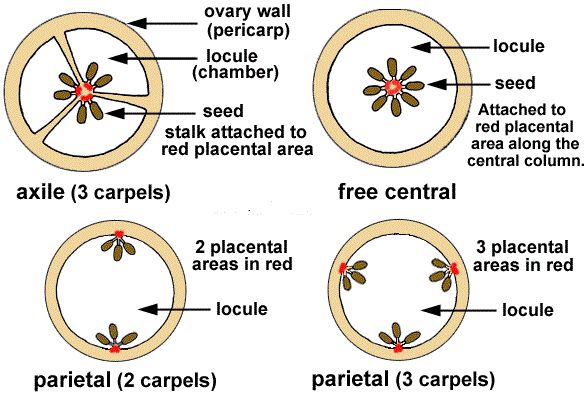
The Fruit
The Fruit
Fruit is a seed-bearing structure generated from the ovary after flowering in flowering plants. Fruits are the vehicles via which flowering plants spread their seeds. Fruit is a distinguishing feature of flowering plants. A ripened that has matured following fertilization is the fruit.
A parthenocarpic fruit is one that is generated without the ovary being fertilized like a banana, cucumber, grape, orange. Etc. A wall or pericarp surrounds the seeds in most fruits. The pericarp might be meaty or dry. The outer epicarp, middle mesocarp, and inner endocarp are formed when the pericarp becomes thick and fleshy. The fruit is called a drupe in mango and coconut. They are single-seeded and develop from monocarpellary superior ovaries.The pericarp of mango is divided into three layers: an exterior thin epicarp, a middle fleshy edible mesocarp, and an inner stony hard endocarp. The mesocarp of coconut, which is also a drupe, is fibrous.
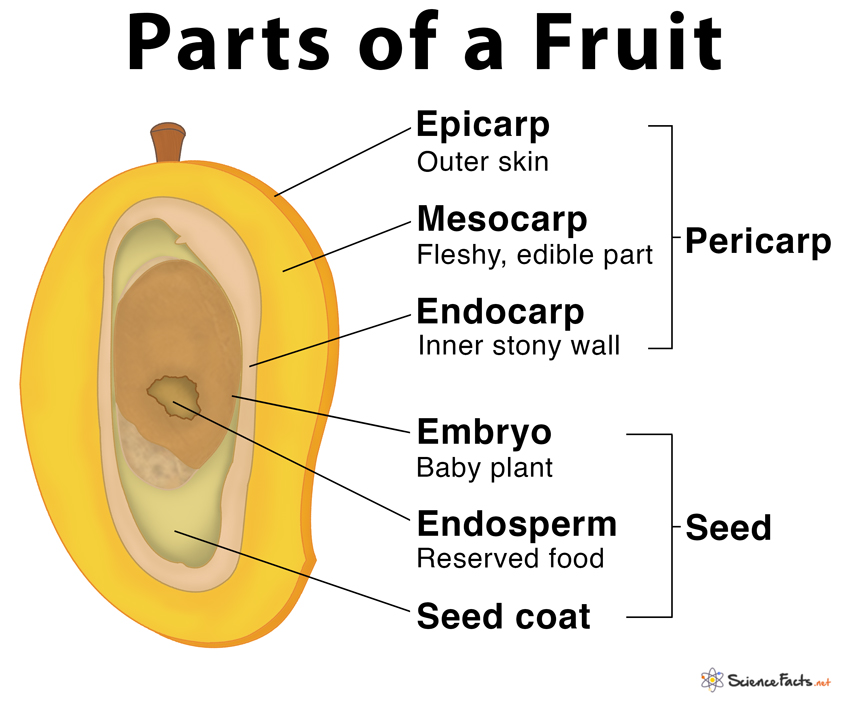
Fruits can be broadly classified into:
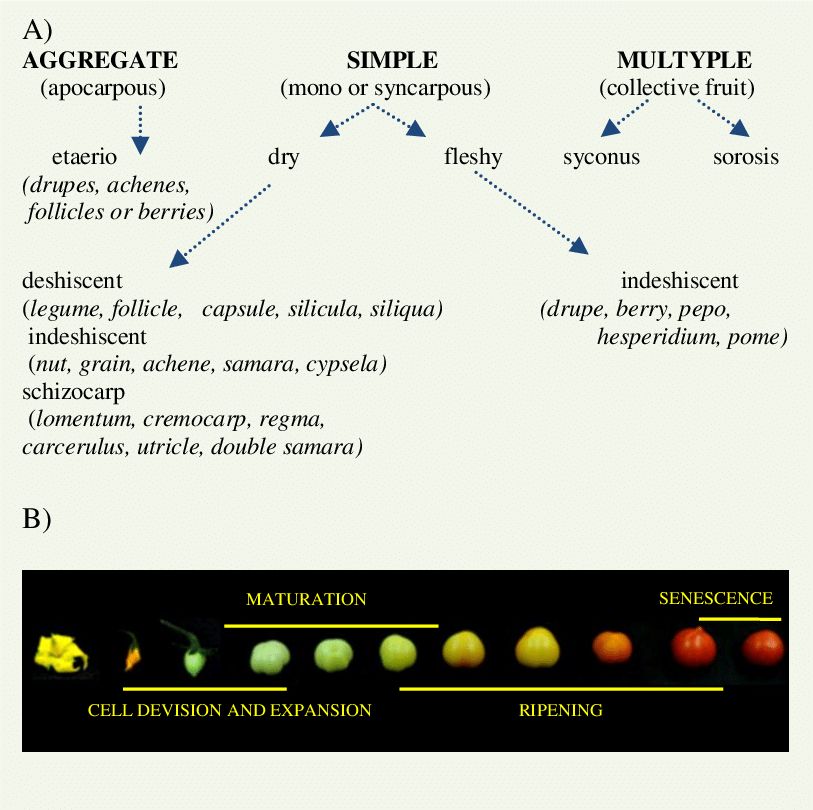
a. Simple Fruit: It is an indehiscent fruit derived from a single ovary having one or many seeds within a fleshy wall or pericarp: e.g. grape; tomato; cranberry.A simple fruit is further classified as dry or fleshy.
b. Aggregate fruit: Itdevelops from a flower having a polycarpellary apocarpous pistil. Each ovary develops into single simple fruit. Examples are blackberries and raspberries where each fleshy lobe is actually an individual fruit joined at their bases.
c. Multiple fruits: They are also called collective fruits. In this, the fruiting bodies are formed from a cluster of flowers, the inflorescence. Each flower in the inflorescence produces a fruit, but these mature into a single mass. After flowering, the mass is called an infructescence.Examples are, Pineapple and Mulberry.
Fruits are also classified on the basis of formation as True fruits, False fruits, and Parthenocarpic fruits.
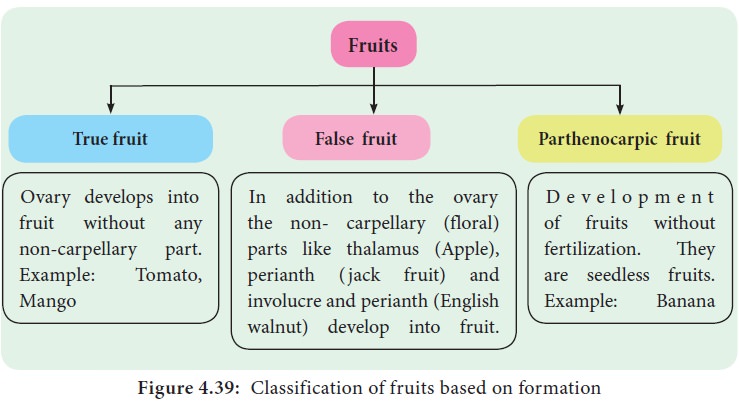
The Seed
The Seed
After fertilization, the ovules mature into seeds. A seed consists of two parts: a seed coat and an embryo. A radicle, an embryonal axis, and one (as in wheat, maize) or two cotyledons make up the embryo (as in gram and pea).
Structure of a Dicotyledonous Seed:
The seed coat is a seed's outermost coating. The outer testa and the inner tegmen are the two layers of the seed coat. The hilum is a scar on the seed coat that was used to adhere the developing seeds to the fruit.The micropyle is a tiny pore located above the hilum. The embryo, which consists of an embryonal axis and two cotyledons, is contained within the seed coat. The cotyledons are usually plump and rich in food reserves. The radicle and the plumule are located at the two ends of the embryonal axis. The endosperm developed as a result of multiple fertilization in some seeds, such as castor, is a food-storing tissue and is referred to as endospermic seeds.The endosperm is absent in mature seeds of plants such as beans, gram, and pea, and these seeds are referred to as non-endospermic.
Structure of Monocotyledonous Seed:
Monocotyledonous seeds are usually endospermic, but some, such as those found in orchids, are not. The seed coat of cereal seeds, such as maize, is membranous and usually united with the fruit wall. The endosperm is a thick substance that stores food. A protein layer termed aleurone separates the embryo from the endosperm's outer covering. The embryo is tiny and rests in a groove on one end of the endosperm. It consists of a scutellum, a big shield-shaped cotyledon, and a short axis with a plumule and radicle. Coleoptile and coleorhiza are sheaths that surround the plumule and radicle, respectively.
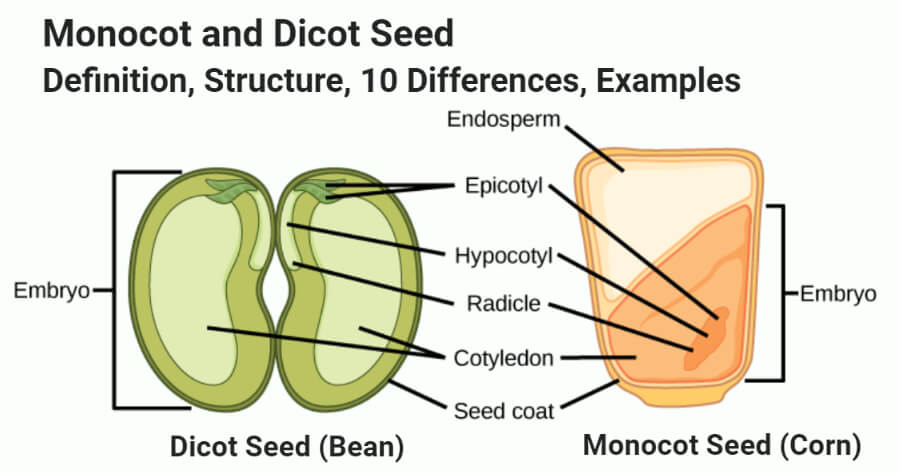
Semi-Technical Description of a Typical Flowering Plant
Semi-Technical description of a typical flowering plant
A flowering plant is described using morphological characteristics.Vegetative elements such as roots, stems, and leaves are covered first in a semi-technical description of the flowering plant's behavior, followed by floral characters such as inflorescence and flower components.
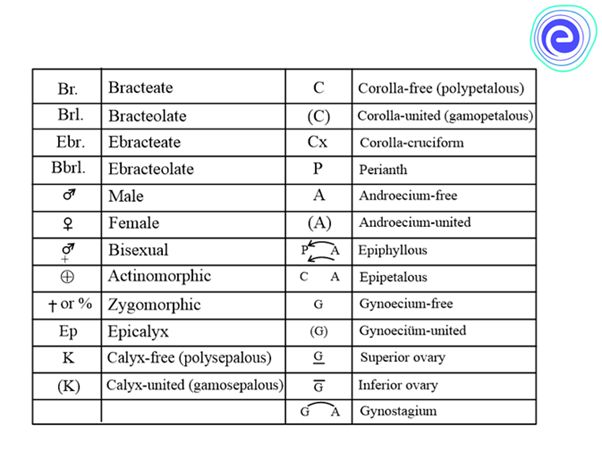
Various symbols in a floral formula are given above. The description must be concise, written in plain, scientific language, and given in a logical order. The plant's habitatand vegetative characteristics (roots, stem, and leaves) are detailed first, followed by floral characters (inflorescence and flower components). A floral diagram is a visual representation of the structure of a flower. It depicts the number, arrangement, and fusion of floral organs. The flower's various components are represented by their respective symbols. Floral diagrams can be used to identify flowers or to better understand angiosperm evolution.The floral formula is a traditional way of describing a flower's structure. It designates different components of the flower with a combination of capital letters and symbols. A floral diagram and a floral formula are offered after discussing various elements of the plant. A floral diagram of a mustard plant is given below.
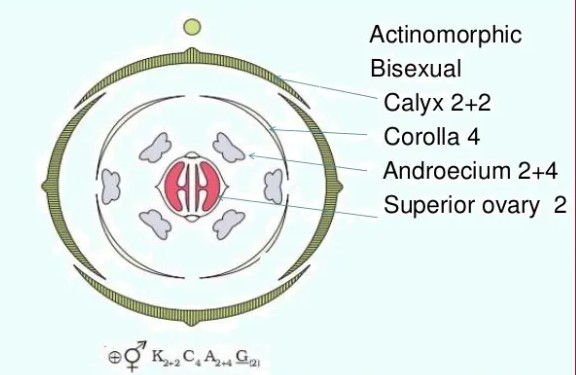
Some important families
Description of some important families
A. FABACEAE
It is also called Leguminosae, It consists of legumes such as the pea, or bean family, and is a large and agriculturally important family of flowering plants.
Vegetative Characters
Root: Dicotyledons, taproot with root nodules.
Stem: Erect or climber; Fabaceae includes shrubs, herbs, trees and majorly climbers.
Leaves: Petiolate, pinnately compound or simple; pulvinus leaf base, stipulate; reticulate venation.
Floral Characters
Inflorescence: Racemose.
Flower: Complete, bisexual, zygomorphic, hypogynous, bracteate/ ebracteate.
Calyx: Five sepals, gamosepalous; valvate or imbricate aestivation.
Corolla: Five petals, polypetalous, papilionaceous, vexillary aestivation.
Androecium: Ten stamens (9+1), diadelphous, anther dithecous.
Gynoecium: Superior ovary, monocarpellary, unilocular, single, short -style and flat, hairy-stigma.
Fruit: Legume.
Seed: One or more, non-endospermic.
Economic Importance
Many plants belonging to this family are economically useful. A few of them are listed below:
The plants of this family are unique and have root nodules that contain nitrogen-fixing symbiotic bacteria, capable of transforming atmospheric nitrogen into fixed nitrogen or ammonia. Pulses like gram, moong, and soya bean are the main source of food. The Mulethiplant is known for its medicinal value. Soya bean and groundnuts are used to extract oil that is used for cooking. Sunn hemp is the source
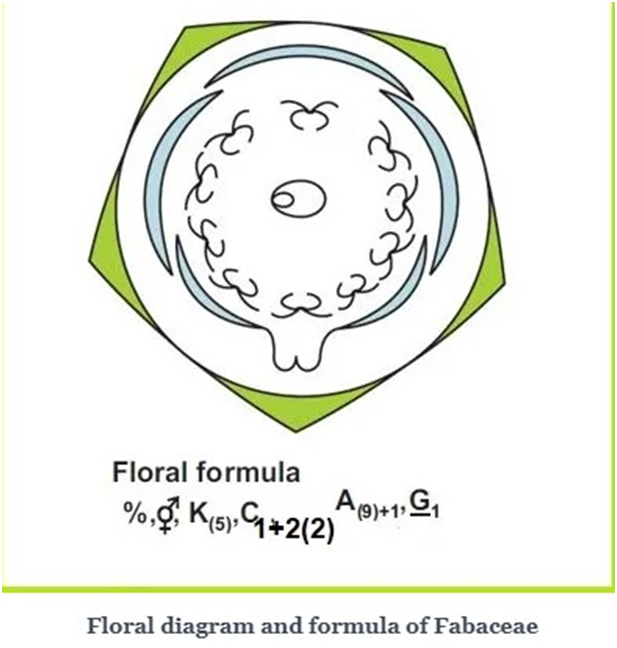
B. SOLANACEAE
It is a family of flowering plants that ranges from annual and perennial herbs to vines, epiphytes, shrubs, and trees, and includes a number of agricultural crops, medicinal plants, spices, weeds, and ornamentals.
Vegetative Characters
Root System: Taproot system.
Stem: Erect or climber; Solanaceae includes herbs, shrubs, small trees, and climbers.
Leaves: Alternate, simple or pinnately compound (rarely); exstipulate; reticulate venation.
Floral characters
Inflorescence: Racemose- terminal or axillary raceme; Cymose- solitary in Solanum.
Flower: Complete, bisexual, actinomorphic, hypogynous.
Calyx: Five sepals, gamosepalous; valvate aestivation.
Corolla: Five petals, gamopetalous, valvate aestivation.
Androecium: Five stamens, epipetalous; anthers basifixed.
Gynoecium: Syncarpous, bicarpellary, bilocular, superior ovary, axile placentation.
Fruit: Berry/ capsule.
Seed: Numerous, endospermic.
Economic Importance
These are an important source of food. E.g. tomato, brinjal and potato. These are important sources of spices. E.g. chilly. The leaves of Nicotiana tabacum are a major source of tobacco.These are also used as ornamental plants. E.g. petunia. Plants such as Belladonna and Ashwagandha are also used as medicinal plants.
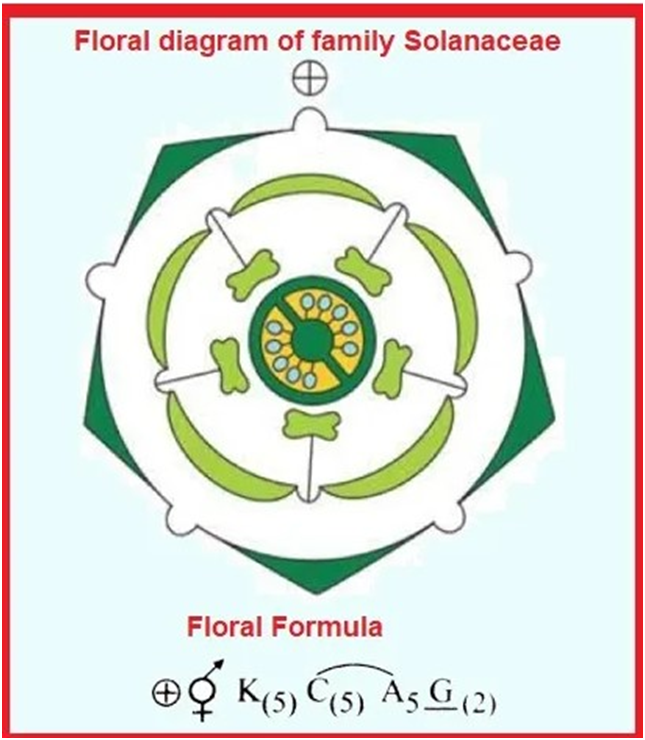
C. LILIACEAE
Liliaceae is the family of around 2500 species of perennial, herbaceous monocots. It is also known as the ‘lily family’.
Vegetative Characters
Root: Fibrous root system.
Stem: Erect; Liliaceae includes perennial herbs which propagate through bulbs or rhizomes.
Leaves: Alternate, simple; exstipulate; parallel venation.
Floral characters
Inflorescence: Cymose- solitary; umbellate clusters.
Flower: Complete, bisexual, actinomorphic; hypogynous, perianth present.
Perianth: Indistinctive sepal and petal; six tepals (3+3), often united tepals; valvate aestivation.
Androecium: Six stamens in two whorls (3+3).
Gynoecium: Syncarpous, tricarpellary, trilocular, superior ovary with axile placentation.
Fruit: Mostly Capsule and sometimes berry.
Seed: Endospermic seeds.
Economic Importance
The plants belonging to the Liliaceae family are a source of Medicine -Aloe vera, Smilax and Colchicine. They are also used as ornamental plants -Lilium, tulips, Gloriosa, and Ruscus. They are also exploited as a source of food (or) Vegetables-Asparagus.Bulbs of Allium cepa and the roots of various species of Smilax are used as flavouring agents.


 ACME SMART PUBLICATION
ACME SMART PUBLICATION
